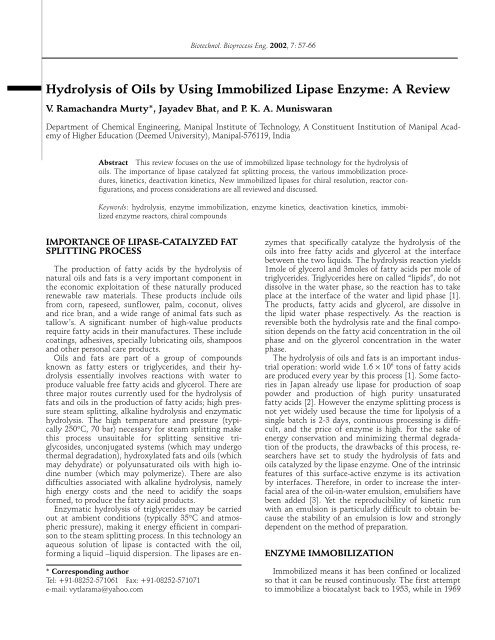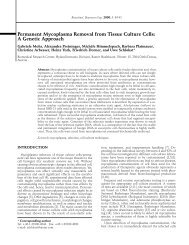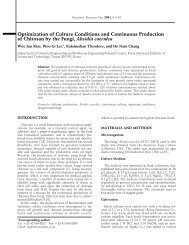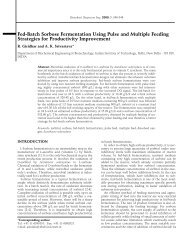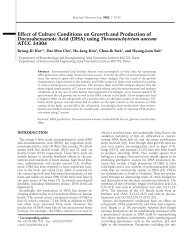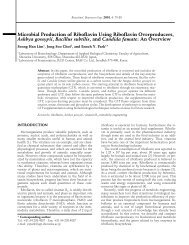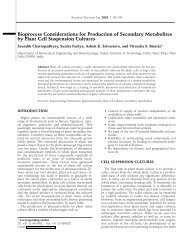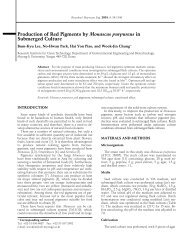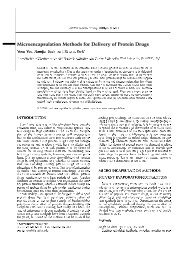Hydrolysis of Oils by Using Immobilized Lipase Enzyme: A Review
Hydrolysis of Oils by Using Immobilized Lipase Enzyme: A Review
Hydrolysis of Oils by Using Immobilized Lipase Enzyme: A Review
Create successful ePaper yourself
Turn your PDF publications into a flip-book with our unique Google optimized e-Paper software.
Biotechnol. Bioprocess Eng. 2002, 7: 57-66<br />
<strong>Hydrolysis</strong> <strong>of</strong> <strong>Oils</strong> <strong>by</strong> <strong>Using</strong> <strong>Immobilized</strong> <strong>Lipase</strong> <strong>Enzyme</strong>: A <strong>Review</strong><br />
V. Ramachandra Murty*, Jayadev Bhat, and P. K. A. Muniswaran<br />
Department <strong>of</strong> Chemical Engineering, Manipal Institute <strong>of</strong> Technology, A Constituent Institution <strong>of</strong> Manipal Academy<br />
<strong>of</strong> Higher Education (Deemed University), Manipal-576119, India<br />
Abstract This review focuses on the use <strong>of</strong> immobilized lipase technology for the hydrolysis <strong>of</strong><br />
oils. The importance <strong>of</strong> lipase catalyzed fat splitting process, the various immobilization procedures,<br />
kinetics, deactivation kinetics, New immobilized lipases for chiral resolution, reactor configurations,<br />
and process considerations are all reviewed and discussed.<br />
Keywords: hydrolysis, enzyme immobilization, enzyme kinetics, deactivation kinetics, immobilized<br />
enzyme reactors, chiral compounds<br />
IMPORTANCE OF LIPASE-CATALYZED FAT<br />
SPLITTING PROCESS<br />
The production <strong>of</strong> fatty acids <strong>by</strong> the hydrolysis <strong>of</strong><br />
natural oils and fats is a very important component in<br />
the economic exploitation <strong>of</strong> these naturally produced<br />
renewable raw materials. These products include oils<br />
from corn, rapeseed, sunflower, palm, coconut, olives<br />
and rice bran, and a wide range <strong>of</strong> animal fats such as<br />
tallow’s. A significant number <strong>of</strong> high-value products<br />
require fatty acids in their manufactures. These include<br />
coatings, adhesives, specially lubricating oils, shampoos<br />
and other personal care products.<br />
<strong>Oils</strong> and fats are part <strong>of</strong> a group <strong>of</strong> compounds<br />
known as fatty esters or triglycerides, and their hydrolysis<br />
essentially involves reactions with water to<br />
produce valuable free fatty acids and glycerol. There are<br />
three major routes currently used for the hydrolysis <strong>of</strong><br />
fats and oils in the production <strong>of</strong> fatty acids; high pressure<br />
steam splitting, alkaline hydrolysis and enzymatic<br />
hydrolysis. The high temperature and pressure (typically<br />
250°C, 70 bar) necessary for steam splitting make<br />
this process unsuitable for splitting sensitive triglycosides,<br />
unconjugated systems (which may undergo<br />
thermal degradation), hydroxylated fats and oils (which<br />
may dehydrate) or polyunsaturated oils with high iodine<br />
number (which may polymerize). There are also<br />
difficulties associated with alkaline hydrolysis, namely<br />
high energy costs and the need to acidify the soaps<br />
formed, to produce the fatty acid products.<br />
Enzymatic hydrolysis <strong>of</strong> triglycerides may be carried<br />
out at ambient conditions (typically 35°C and atmospheric<br />
pressure), making it energy efficient in comparison<br />
to the steam splitting process. In this technology an<br />
aqueous solution <strong>of</strong> lipase is contacted with the oil,<br />
forming a liquid –liquid dispersion. The lipases are en-<br />
* Corresponding author<br />
Tel: +91-08252-571061 Fax: +91-08252-571071<br />
e-mail: vytlarama@yahoo.com<br />
zymes that specifically catalyze the hydrolysis <strong>of</strong> the<br />
oils into free fatty acids and glycerol at the interface<br />
between the two liquids. The hydrolysis reaction yields<br />
1mole <strong>of</strong> glycerol and 3moles <strong>of</strong> fatty acids per mole <strong>of</strong><br />
triglycerides. Triglycerides here on called “lipids”, do not<br />
dissolve in the water phase, so the reaction has to take<br />
place at the interface <strong>of</strong> the water and lipid phase [1].<br />
The products, fatty acids and glycerol, are dissolve in<br />
the lipid water phase respectively. As the reaction is<br />
reversible both the hydrolysis rate and the final composition<br />
depends on the fatty acid concentration in the oil<br />
phase and on the glycerol concentration in the water<br />
phase.<br />
The hydrolysis <strong>of</strong> oils and fats is an important industrial<br />
operation: world wide 1.6 × 10 6 tons <strong>of</strong> fatty acids<br />
are produced every year <strong>by</strong> this process [1]. Some factories<br />
in Japan already use lipase for production <strong>of</strong> soap<br />
powder and production <strong>of</strong> high purity unsaturated<br />
fatty acids [2]. However the enzyme splitting process is<br />
not yet widely used because the time for lipolysis <strong>of</strong> a<br />
single batch is 2-3 days, continuous processing is difficult,<br />
and the price <strong>of</strong> enzyme is high. For the sake <strong>of</strong><br />
energy conservation and minimizing thermal degradation<br />
<strong>of</strong> the products, the drawbacks <strong>of</strong> this process, researchers<br />
have set to study the hydrolysis <strong>of</strong> fats and<br />
oils catalyzed <strong>by</strong> the lipase enzyme. One <strong>of</strong> the intrinsic<br />
features <strong>of</strong> this surface-active enzyme is its activation<br />
<strong>by</strong> interfaces. Therefore, in order to increase the interfacial<br />
area <strong>of</strong> the oil-in-water emulsion, emulsifiers have<br />
been added [3]. Yet the reproducibility <strong>of</strong> kinetic run<br />
with an emulsion is particularly difficult to obtain because<br />
the stability <strong>of</strong> an emulsion is low and strongly<br />
dependent on the method <strong>of</strong> preparation.<br />
ENZYME IMMOBILIZATION<br />
<strong>Immobilized</strong> means it has been confined or localized<br />
so that it can be reused continuously. The first attempt<br />
to immobilize a biocatalyst back to 1953, while in 1969
58 Biotechnol. Bioprocess Eng. 2002, Vol. 7, No. 2<br />
<br />
an immobilized enzyme was used for the first time in Ionic Binding<br />
an industrial process, since then this technique has<br />
gained more and more importance, and now a wide<br />
variety <strong>of</strong> immobilized enzymes are employed in the<br />
food, pharmaceutical and chemical industries. Although<br />
lipases presently account for no more than 3% <strong>of</strong> all<br />
enzymes produced worldwide, the use <strong>of</strong> immobilized<br />
lipases for the modification <strong>of</strong> melted fats and oils is<br />
currently a subject <strong>of</strong> expanding interest. This interest<br />
It is based on electrostatic interactions (ionic and hydrogen<br />
bonding) between differently charged ionic<br />
groups <strong>of</strong> the matrix and <strong>of</strong> the enzymes. The advantages<br />
and disadvantages are the same <strong>of</strong> the adsorption<br />
process, but through ionic binding the enzyme conformation<br />
is influenced more than through adsorption and<br />
less than through covalent binding. Different anion exchange<br />
is due in part to the fact that the use <strong>of</strong> lipases has the<br />
materials, like DEAE-cellulose or DEAE-<br />
potential to be more cost effective when enzymes are Sephadex are used as matrices.<br />
employed in immobilized rather than in free form. In<br />
principle immobilized lipase technology would facilitate Covalent Binding<br />
the development <strong>of</strong> continuous, large-scale commercial<br />
processes (as opposed to most small scale, batch operations<br />
that employ soluble lipases for the production <strong>of</strong><br />
food flavors) which have a high efficiency per unit volume<br />
<strong>of</strong> reactor corresponding high rate <strong>of</strong> return <strong>of</strong><br />
capital costs [4]. Further more, the use <strong>of</strong> immobilized<br />
lipases leads to a decrease in potential for contamination<br />
<strong>of</strong> the product via residual lipases, thus avoiding<br />
the need for down stream thermal treatment. Immobilization<br />
also permits multiple uses <strong>of</strong> the lipases and<br />
<strong>of</strong>ten enhances its thermal and chemical stability, thus<br />
leading to predictable decay rates. It also enhances opportunities<br />
for better control <strong>of</strong> both the process and<br />
This method is based on the formation <strong>of</strong> covalent<br />
bonds between a support material and some functional<br />
groups <strong>of</strong> the amino acid residues on the surface <strong>of</strong> the<br />
enzyme. Usually, the support has to be first activated<br />
<strong>by</strong> a specific reagent, to make its functional groups<br />
strongly electrophilic; these groups are then allowed to<br />
react with strong nucleophilic groups <strong>of</strong> the enzyme.<br />
The advantage <strong>of</strong> this method is the strength <strong>of</strong> the<br />
bond and the consequent stability <strong>of</strong> immobilization;<br />
the disadvantages are the higher costs and the lower<br />
yields, as the enzyme conformation and <strong>of</strong> course activity<br />
will be strongly influenced <strong>by</strong> the covalent binding.<br />
product quality. In fact the incremental costs <strong>of</strong> using<br />
an immobilized biocatalyst in a continuous process are Cross-linking<br />
more than 20 times lower than with a traditional one,<br />
arising primarily from the cost <strong>of</strong> the relatively large<br />
amount <strong>of</strong> non-reusable enzyme required <strong>by</strong> the latter<br />
process. The main disadvantages <strong>of</strong> immobilization can<br />
be, loss <strong>of</strong> activity due to immobilization, limitation in<br />
substrate’s diffusion, possible leakage <strong>of</strong> the biocatalyst<br />
from the support.<br />
This type <strong>of</strong> immobilization is support –free and involves<br />
joining the enzymes to each other to form a<br />
three-dimensional structure. The bond is formed <strong>by</strong><br />
means <strong>of</strong> a bi-or multifunctional reagent such as glutaraldyhyde.<br />
The disadvantages are the very low immobilization<br />
yields, the absence <strong>of</strong> mechanical properties and<br />
the poor stability.<br />
METHODS OF IMMOBILIZATION<br />
Numerous methods for achieving the immobilization<br />
<strong>of</strong> lipases are available; each involves a different degree<br />
<strong>of</strong> complexity and efficiency. The various methods used<br />
to date are: adsorption [3-10], ionic bonding, covalent<br />
binding [11], cross-linking [12], entrapment, and encapsulation<br />
[13].<br />
Adsorption<br />
It is the simplest method and involves reversible surface<br />
interactions between enzymes and support material.<br />
The forces involved are mostly hydrophobic.<br />
Among the advantages are: it is a cheap, fast and simple<br />
process; no chemical changes to support or enzymes are<br />
necessary; it is a reversible immobilization. Disadvantages<br />
are the leakage <strong>of</strong> the enzyme from the support,<br />
the possible steric hindrance <strong>by</strong> the support and the<br />
nonspecific binding. Inorganic (activated carbon, silica,<br />
etc.) or organic (natural or synthetic polymers) compounds<br />
can be used as supports.<br />
Entrapment<br />
<strong>Using</strong> this method, the enzyme is free in solution,<br />
but restricted in movement <strong>by</strong> the lattice structure <strong>of</strong> a<br />
gel. There are different methods for the entrapment<br />
such as temperature-induced gelation, polymerization<br />
<strong>by</strong> chemical/photochemical reaction, ionotropic gelation<br />
<strong>of</strong> macromolecules with multivalent cations.<br />
Entrapment is mainly used for immobilization <strong>of</strong> cells,<br />
but has the inevitable disadvantage that the support<br />
will act as a barrier to mass transfer.<br />
Encapsulation<br />
Encapsulation <strong>of</strong> enzymes or cells can be achieved <strong>by</strong><br />
enveloping the biological components within various<br />
forms <strong>of</strong> semi permeable membranes, usually microcapsules<br />
varying from 10-100 µm in diameter. Large proteins<br />
cannot pass out <strong>of</strong> or into the capsule, but small<br />
substrates and products can pass freely across the semi<br />
permeable membrane. A disadvantage is the acute diffusion<br />
problem; an advantage can be the co-immobilization<br />
<strong>of</strong> different enzymes/cells to suit particular ap-
Biotechnol. Bioprocess Eng. 2002, Vol. 7, No. 2 59<br />
<br />
plications.<br />
V max, i = k cat,i [] E tot<br />
(6)<br />
The selection <strong>of</strong> an immobilization strategy is based<br />
on process specifications for the catalyst, including such The above equation is based on the following assumptions:<br />
(1) the Michaelis-Menten constants, K mi<br />
parameters as overall enzymatic activity, effectiveness<br />
,<br />
<strong>of</strong> lipase utilization, deactivation and regeneration associated with every substrate S i<br />
(out <strong>of</strong> N possible<br />
characteristics, cost <strong>of</strong> the immobilization procedure, substrates) are approximately equal; and (2) all [S i<br />
]/K mi<br />
toxicity <strong>of</strong> immobilization reagents and the final properties<br />
<strong>of</strong> the immobilized lipase [4].<br />
Three rate expressions were utilized based on Mi-<br />
are very large compared to unity.<br />
chaelis-Menten kinetics and a ping-pong bi-bi mechanism<br />
to fit the uniresponse experimental data for the<br />
KINETICS OF THE ENZYMATIC REACTION total rate <strong>of</strong> release <strong>of</strong> fatty acids.<br />
Several mechanisms have been proposed for lipase<br />
catalysis reactions [14]. The vast majorities <strong>of</strong> these<br />
mechanisms were developed for the case <strong>of</strong> soluble lipases<br />
acting on insoluble substrates (e.g. oil droplets<br />
dispersed in water). However, in the absence <strong>of</strong> diffusional<br />
limitations the validity <strong>of</strong> the aforementioned<br />
mechanism easily extended to include the most complex<br />
case <strong>of</strong> having the lipases present in immobilized<br />
states. The simplest kinetic model applied to describe<br />
lipase-catalyzed reaction is based on the classic Michaelis-Menten<br />
mechanism as applied to emulsified oil/<br />
water systems [15]. The kinetic steps can be represented<br />
schematically as:<br />
k 1<br />
k cat<br />
E + S ES E+P+Q (1)<br />
k -1<br />
here E denotes the immobilized enzyme, S the substrate<br />
(glycerides), ES the enzyme-substrate complex and P<br />
and Q the products (hydrolyzed glycerides and free<br />
fatty acids). The rate <strong>of</strong> formation <strong>of</strong> free fatty aciids<br />
per unit volume <strong>of</strong> reacting fluid (r v<br />
) can be represented<br />
in terms <strong>of</strong> this mechanism as:<br />
[] []<br />
rv = Vmax<br />
S Km<br />
+ S<br />
(2)<br />
V max<br />
= k cat<br />
[E] tot<br />
(3)<br />
K<br />
m<br />
= k<br />
cat<br />
+ k<br />
−1<br />
k<br />
1<br />
Where V max<br />
is the rate observed when the lipase is saturated<br />
with substrate, K m<br />
is the Michaelis-Menten constant,<br />
the bracket denote molar concentrations <strong>of</strong> the<br />
various species, and the subscript tot denotes the total<br />
amount.<br />
In the case <strong>of</strong> feed stocks from natural origin which<br />
contain more one chemical species susceptible to lipase<br />
action (e.g., butter fat), the Michaelis-Menten mechanism<br />
denoted as equation (2) may be extended in order<br />
to include competitive inhibition <strong>by</strong> every substrate, S i<br />
with respect to each other. For extent <strong>of</strong> hydrolysis below<br />
70%, a pseudo-zero order rate expression arises<br />
which takes the form<br />
r<br />
<br />
VS<br />
<br />
=<br />
<br />
∑S<br />
<br />
=<br />
<br />
<br />
(4)<br />
(5)<br />
Model A: r V,hyd,A<br />
= θ A,1<br />
[G] (7)<br />
Model B : r<br />
Model C : r<br />
V,hyd,B<br />
V,hyd,C<br />
where r V,hyd,A<br />
, r , and r V,hyd,B V,hyd,C<br />
correspond to the effective<br />
rate <strong>of</strong> reaction per unit volume (M/h) for the various<br />
models, [G] is the concentration (M) <strong>of</strong> glyceride<br />
moieties (accessible ester bonds, and θ i<br />
represent<br />
lumped parameter related to the rate parameter appearing<br />
in the various Michaelis-Menten models (V max<br />
parameter,<br />
and Michaelis and inhibition constant). These<br />
rate expressions are identical in mathematical form to<br />
those employed <strong>by</strong> Malcata et al. [16,17]. If the feedstock<br />
does not contain, initially, significant amount <strong>of</strong><br />
free fatty acids, then [G] can be determined <strong>by</strong> the following<br />
equation.<br />
(8)<br />
(9)<br />
[G] =[G 0<br />
] - [FA] (10)<br />
Where [G 0<br />
] represents the initial concentration <strong>of</strong> glyceride<br />
bonds accessible to hydrolysis and [FA] is the concentration<br />
<strong>of</strong> free fatty acids resulting from hydrolysis.<br />
Deactivation Kinetics<br />
θ<br />
B,1[<br />
G]<br />
=<br />
1+ θ B,2[<br />
G]<br />
θC,1[<br />
G]<br />
=<br />
1+ θ [ G]<br />
+ θ<br />
C,2<br />
One <strong>of</strong> disadvantages, and probably the most serious<br />
disadvantage, <strong>of</strong> biocatalyst is that they lose their catalytic<br />
activities during the reaction. This phenomenon is<br />
well recognized in biotechnology and is called decay,<br />
inactivation, or denaturation <strong>of</strong> the biocatalyst. Even if<br />
the life <strong>of</strong> a biocatalyst can be prolonged <strong>by</strong> its immobilization,<br />
it still loses its activity sooner or later. The<br />
catalytic durability <strong>of</strong> the biocatalyst during continuous<br />
operation is called operation stability. The operational<br />
stability <strong>of</strong> a biocatalyst is estimated <strong>by</strong> its half-life,<br />
which is the elapsed time at which the catalytic activity<br />
is reduced to half. The half-life is a very important parameter<br />
that governs the economical feasibility <strong>of</strong> the<br />
bioprocess concerned [18].<br />
Two methods are known to evaluate the deactivating<br />
catalyst during continuous operation. For the most<br />
common case continuous operation is performed so as<br />
to keep the conversion fixed (constant conversion). This<br />
requires decreasing flow rate as the enzyme activity<br />
drops gradually. In other method the flow rates (or the<br />
C,3<br />
2<br />
[ G]
60 Biotechnol. Bioprocess Eng. 2002, Vol. 7, No. 2<br />
<br />
space velocity) is kept constant throughout the continuous<br />
operation (constant feed rate or constant space tor <strong>of</strong> modulator J in inactivation stage i. For instance,<br />
k iJ<br />
= k i<br />
(1-n iJ<br />
) where n iJ<br />
represents the modulation fac-<br />
velocity) to observe the decrease in the outlet conversion.<br />
The former method requires a precise feed back tive inhibition, three enzyme species will exist : the free<br />
in the case <strong>of</strong> an enzyme subjected to product competi-<br />
control strategy. Otherwise, trial and error in changing enzyme (E) and the secondary enzyme-substrate (ES)<br />
the flow rate is inevitable as the exact pr<strong>of</strong>ile <strong>of</strong> the activity<br />
decay is unknown prior to the experiment. Be-<br />
enzyme will be distributed during the course <strong>of</strong> cataly-<br />
and enzyme-product (EP) complexes, among which the<br />
cause <strong>of</strong> the ease <strong>of</strong> experimentation, the later policy sis.<br />
has been <strong>of</strong>ten applied in the biotechnological area.<br />
Generally, deactivation rates are determined in the absence<br />
<strong>of</strong> substrate, but enzyme deactivation rates can IMMOBILIZED LIPASES FOR CHIRAL<br />
be considerably modified <strong>by</strong> the presence <strong>of</strong> substrate RESOLUTION<br />
and other materials.<br />
Biocatalyst thermal stability is a fundamental aspect The chemical industry has been using enzymes for<br />
in the reactor performance. Despite this, most information<br />
on biocatalyst stability, being gathered under noncently,<br />
substances having "chirality" have become <strong>of</strong><br />
biotransformation <strong>of</strong> molecules for many years. Rereactive<br />
conditions, is <strong>of</strong> limited use, leaving aside great significance to the pharmaceutical industry, and<br />
modulation effects <strong>by</strong> substrate and products, which enzymes are important for manipulating this characteristic.<br />
certainly play a role during catalysis. Only in few cases,<br />
the modulation <strong>of</strong> enzyme inactivation <strong>by</strong> reagents and<br />
products has been studied and made explicit in reactor Importance <strong>of</strong> Chirality<br />
modeling [19-22].<br />
Different mechanisms have been proposed to describe<br />
enzyme thermal inactivation. The simplest and most<br />
used is one stage first-order kinetics, which proposes<br />
the transition <strong>of</strong> a fully active native enzyme to a fully<br />
inactivated species in a single step. Such mechanism<br />
leads to a model <strong>of</strong> exponential decay:<br />
e<br />
= exp( −kDt)<br />
(11)<br />
eo<br />
Thermal inactivation is certainly more complex and<br />
series and parallel mechanisms have been proposed to<br />
describe it [23]. Models derived from such mechanisms<br />
contain a high number <strong>of</strong> parameters, which are difficult<br />
to determine experimentally. However, a twophase<br />
series mechanism usually represents well the<br />
phenomenon in terms <strong>of</strong> a limited number <strong>of</strong> parameters<br />
susceptible to reliable experimental determination.<br />
A model based on such mechanism is represented <strong>by</strong><br />
equation (12):<br />
e ⎡ k ⎤<br />
1<br />
k1<br />
= ⎢1 + A ⎥exp(<br />
−k1t<br />
) − A exp(<br />
−k2t)<br />
eo<br />
⎣ k1<br />
− k2<br />
⎦<br />
k1<br />
− k2<br />
(12)<br />
Synthetic compounds that exhibit chirality are usually<br />
found to have almost equal amounts <strong>of</strong> both the<br />
forms <strong>of</strong> the molecules (isomers), i.e. they are found as a<br />
mixture. However, it is <strong>of</strong>ten found that only one isomer<br />
has the desired properties <strong>of</strong> the compound, whilst<br />
the other isomer may be inactive or sometimes harmful.<br />
Thalidomide is an example <strong>of</strong> such a molecule having a<br />
desirable and effective isomer and a seriously harmful<br />
isomer. Safer drugs are required and expected.<br />
What Are Chiral Compounds<br />
• The difference in the activity <strong>of</strong> the two isomers <strong>of</strong> a<br />
chiral compound derive from the following characteristics:<br />
• 4 arms (bonds) <strong>of</strong> the carbon atom connect to different<br />
elements or chemical groups.<br />
• This gives “left and right handed” structures (mirror<br />
images).<br />
• Both isomers are chemically identical<br />
Why Different Bioactivity<br />
Where e stands for enzyme activity, e o<br />
is its initial<br />
value, t stands for time, k 1<br />
and k 2<br />
are the transition rate<br />
constants in each inactivation stage and A is the specific<br />
activity ratio between the intermediate and initial<br />
enzyme stage. These models have been traditionally<br />
used to evaluate enzyme stability under non-reactive<br />
conditions [24], so that parameters obtained do not<br />
reflect the behavior in the presence <strong>of</strong> substrate and<br />
products as it occurs in the reactor. It has been postulated<br />
that any substrate that interacts with the enzyme<br />
during catalysis is a potential modulator <strong>of</strong> enzyme stability<br />
[25].<br />
Therefore<br />
-d[E i<br />
J]/dt= k iJ<br />
[E i<br />
J] (13)<br />
Although chemically identical, and <strong>of</strong>ten very difficult<br />
to separate <strong>by</strong> chemical means, the two different<br />
spatial forms (optical isomers) <strong>of</strong> a chiral molecule may<br />
be recognized differently in a living organism. It is very<br />
important to be able to prepare the individual isomers<br />
in a pure form so that only the beneficial properties are<br />
expressed. This is why the production <strong>of</strong> "chiral compounds"<br />
is so important in leading to new and safer<br />
pharmaceuticals.<br />
How Can Compounds Are Resolved<br />
1. The two forms <strong>of</strong> the molecules are called:<br />
“Optical isomers” or “Enantiomers”<br />
2. An equimolar mixture <strong>of</strong> the two is called:
Biotechnol. Bioprocess Eng. 2002, Vol. 7, No. 2 61<br />
<br />
“Racemic mixture” or “Racemate”<br />
3. Separation is called “Resolution”:<br />
Use immobilized lipase to prepare optically pure<br />
Enantiomers because the enzyme modifies only one <strong>of</strong><br />
them and facilitates separation.<br />
Various new lipase enzyme products for chiral synthesis<br />
in various fields such as for biotransformation<br />
use, pharmaceutical use, diagnostic use, and food processing<br />
use are listed in Tables 1-4.<br />
IMMOBILIZED LIPASE REACTORS<br />
The use <strong>of</strong> immobilized lipases for the hydrolysis <strong>of</strong><br />
oils is currently a subject <strong>of</strong> expanding interest. This<br />
interest is partly due to the fact that the use <strong>of</strong> lipases is<br />
more cost effective when these enzymes are employed<br />
in immobilized rather than in free form. In general, the<br />
multiphase reactors considered for this application contain<br />
a solid phase that can be either mobile or stationary<br />
[26].<br />
Several reactor configurations have been used in studies<br />
<strong>of</strong> immobilized lipases. Two types <strong>of</strong> phases are invariably<br />
a solid phase (i.e., the carrier on which the lipase<br />
is immobilized), and one or two liquid phases (i.e.,<br />
feedstocks). If an organic solvent is used to dissolve the<br />
reactant and product species, then only a single-liquid<br />
phase is present in the reactor. The solid phase in twophase<br />
reactors and one <strong>of</strong> the liquid phases in three<br />
phase reactors may appear as a dispersed phase or a<br />
continuous phase. A typical configuration <strong>of</strong> the continuous<br />
solid phase corresponds to a membrane in either<br />
flat sheet or hollow fiber form. Dispersed solid<br />
phases involve the use <strong>of</strong> powders as supports. Whether<br />
the organic or the aqueous phase will constitute the<br />
dispersed phase in the three phase reactors <strong>of</strong>ten depends<br />
on the relative amounts <strong>of</strong> the two liquid phases.<br />
Tables 5-8 consist <strong>of</strong> a compilation <strong>of</strong> the major characteristics<br />
<strong>of</strong> the lipase reactors, which have been described<br />
in the literature.<br />
<strong>Lipase</strong>s act upon substrates that are generally much<br />
more viscous than water at the room temperature.<br />
Hence, one way to overcome the difficulties associated<br />
with operating immobilized lipase reactors for processing<br />
these substrates is <strong>by</strong> the use <strong>of</strong> suitable solvents.<br />
However, the single most important criterion in selecting<br />
a non-aqueous solvents is its compatibility with the<br />
maintenance <strong>of</strong> the catalytic activity and substrate<br />
specificity <strong>of</strong> the lipases. Solvents used to carry out reactions<br />
catalyzed <strong>by</strong> immobilized lipases include benzene,<br />
toluene, n-hexane, n-heptane, octane, iso-octane,<br />
di-isopropyl ether, petroleum ether, etc.<br />
Membrane Reactors<br />
Membrane, or diaphragm, reactors have employed in<br />
the presence <strong>of</strong> one [13] and two liquid phases [4]. In<br />
one type <strong>of</strong> reactor, organic and aqueous phases are<br />
separated <strong>by</strong> a solid membrane in which the lipase is<br />
immobilized. Two types <strong>of</strong> flow patterns have been<br />
employed: flow tangential to and flow normal to the<br />
membrane. For the tangential flow case, both the phases<br />
flow parallel to the membrane in either co-current or<br />
counter current fashion [1,4]. The pressure drop along<br />
the reactor coordinate is small, and no bulk flow<br />
through the membrane is allowed. For flow normal to<br />
the membrane one <strong>of</strong> the phases is pumped through the<br />
Table 1. For biotransformation use<br />
Application Product Form Opt. pH Opt. Temp Specification<br />
Chiral synthesis<br />
Chiral synthesis<br />
Chiral synthesis<br />
Chiral synthesis<br />
Chiral synthesis<br />
Chiral synthesis<br />
<strong>Lipase</strong> AK"Amano"<br />
(Pseudomonas fluorescens)<br />
<strong>Lipase</strong> AYS"Amano"<br />
(Candida rugosa)<br />
<strong>Lipase</strong> AS "Amano"<br />
(Aspergillus niger)<br />
<strong>Lipase</strong> PS "Amano"<br />
(Pseudomonas cepacia)<br />
<strong>Lipase</strong> PS "Amano"<br />
(Pseudomonas cepacia)<br />
<strong>Lipase</strong> PS "Amano"<br />
(Pseudomonas cepacia)<br />
Powder 8.0 55 o C<br />
Powder 7.0 45 o C<br />
Powder 6.5 45 o C<br />
Powder 7.0 50 o C<br />
<strong>Immobilized</strong> on<br />
ceramic particles<br />
<strong>Immobilized</strong> on<br />
diatomaceous earth<br />
7.0 50 o C<br />
7.0 50 o C<br />
20,000 U/g<br />
(pH 7.0)<br />
30,000 U/g<br />
(pH 7.0)<br />
13,500 U/g<br />
(pH 6.5)<br />
30,000 U/g<br />
(pH 7.0)<br />
30,000 U/g<br />
(pH 7.0)<br />
8,000 U/g<br />
(pH 7.0)<br />
Table 2. For pharmaceutical use<br />
Application product Form Opt. pH Stable pH Specification<br />
Digestive preparation<br />
Digestive preparation<br />
New lase (Rhizopus niveus)<br />
<strong>Lipase</strong> AP6 (Aspergillus niger)<br />
Powder<br />
Powder<br />
6.5-7.5<br />
5.0-7.0<br />
4.0-8.0<br />
2.0-10.0<br />
3500 U/g (pH 7.0)<br />
7000 U/g (pH 6.5)
62 Biotechnol. Bioprocess Eng. 2002, Vol. 7, No. 2<br />
<br />
Table 3. For diagnostic use<br />
Application Product Form Opt. pH Opt. Temp Specification<br />
Triglyceride determination<br />
Lipoprotein lipase “Amano”3<br />
(Pseudomonas sp.)<br />
Powder 7.0 50 o C<br />
1,000 U/mg<br />
(pH 6.0)<br />
Triglyceride determination<br />
Lipoprotein lipase “Amano”6<br />
(Microorganism)<br />
Powder 7.0 50 o C<br />
500 U/mg<br />
(pH 6.0)<br />
Table 4. For food processing use<br />
Application Product Form Opt. pH Opt. Temp Specification<br />
Dairy processing<br />
<strong>Lipase</strong> A”Amano”6<br />
(Aspergillus niger)<br />
Powder 6.5 45 o C<br />
60,000 U/g<br />
(pH 6.0)<br />
Dairy processing<br />
<strong>Lipase</strong> A”Amano”10<br />
(Mucor javanicus)<br />
Powder 7.0 40 o C<br />
10,000 U/g<br />
(pH 7.0)<br />
Dairy processing<br />
<strong>Lipase</strong> F-AP 15<br />
(Rhizopus oryzae)<br />
Powder 7.0 40 o C<br />
150,000 U/g<br />
(pH 7.0)<br />
Dairy processing<br />
<strong>Lipase</strong> AY ”Amano”30<br />
(Candida rugosa)<br />
Powder 7.0 45 o C<br />
30,000 U/g<br />
(pH 7.0)<br />
Dairy processing<br />
<strong>Lipase</strong> G”Amano”50<br />
(Penicillium camerbertii)<br />
Powder 5.0 45 o C<br />
50,000 U/g<br />
(pH5.6)<br />
Fats&oils processing<br />
<strong>Lipase</strong> A”Amano” 6<br />
(Aspergillus niger)<br />
Powder 6.5 45 o C<br />
60,000 U/g<br />
(pH 6.0)<br />
Fats&oils processing<br />
<strong>Lipase</strong>M”Amano”10<br />
(Mucor javanicus))<br />
Powder 7.0 40 o C<br />
10,000 U/g<br />
(pH 7.0)<br />
Fats&oils processing<br />
<strong>Lipase</strong>G”Amano” 50<br />
(Pencillium camembertii)<br />
Powder 5.0 45 o C<br />
50,000 U/g<br />
(pH 5.6)<br />
Fats&oils processing<br />
<strong>Lipase</strong> F-AP15<br />
(Rhizopus oryzae)<br />
Powder 7.0 40 o C<br />
150,000 U/g<br />
(pH 7.0)<br />
Fats&oils processing<br />
<strong>Lipase</strong> AY ”Amano” 30<br />
(Candida rugosa)<br />
Powder 7.0 45 o C<br />
30,000 U/g<br />
(pH 7.0)<br />
Fats&oils processing<br />
Newlase F<br />
(Rhizopus niveus)<br />
Powder 7.0 40 o C<br />
30,000 U/g<br />
(pH 7.0)<br />
able 5. Reactors using a membrane support for hydrolysis <strong>of</strong> oils<br />
Type <strong>of</strong> reactor Source <strong>of</strong> lipase Method <strong>of</strong> binding Support Purpose<br />
Tangential flow membrane Candida cylidracea Adsorption Polypropylene <strong>Hydrolysis</strong> <strong>of</strong> olive oil<br />
Flow-thru membrane Candida cylidracea Adsorption Polypropelene <strong>Hydrolysis</strong> <strong>of</strong> oil<br />
Hollow-fiber Candida rugosa Adsorption Cellulose <strong>Hydrolysis</strong> <strong>of</strong> soyabean oil<br />
Flow-thru membrane Aspergillus niger Adsorption Microporous polypropylene <strong>Hydrolysis</strong> <strong>of</strong> butter fat<br />
Flow-thru membrane Aspergillus niger Adsorption Microporous polypropylene <strong>Hydrolysis</strong> <strong>of</strong> butter fat<br />
Ultra filtration ceramic<br />
membrane<br />
Chromobacterium<br />
viscosum<br />
Encapsulation<br />
Reversed micelles <strong>of</strong> dioctyl<br />
sodium sulfosuccinate in<br />
Iso-octane<br />
<strong>Hydrolysis</strong> <strong>of</strong> olive oil<br />
Hollow-fiber Candida cylindracea Adsorption Microporous polypropelene <strong>Hydrolysis</strong> <strong>of</strong> Menhaden oil
Biotechnol. Bioprocess Eng. 2002, Vol. 7, No. 2 63<br />
<br />
Table 6. Packed bed reactors used for hydrolysis <strong>of</strong> oils<br />
Source <strong>of</strong> lipase Method <strong>of</strong> binding Support Purpose<br />
Aspergillus niger<br />
Rhizopus arrhizus<br />
Candida cylindracea<br />
Candida cylidracea<br />
Pseudomonas fluorescens<br />
Candida rugosa<br />
Candida lipolytica<br />
Adsorption<br />
Cell binding<br />
Adsorption<br />
Adsorption<br />
Adsorption<br />
Adsorption<br />
Adsorption<br />
Porous glass<br />
Fungal mycelia<br />
Spherosil<br />
HDPE<br />
Dowex<br />
DEAE-Sephadex, Sephadex G50, Amberlite IRA94<br />
Alumina beads<br />
Oil hydrolysis<br />
Oil hydrolysis<br />
Oil hydrolysis<br />
Oil hydrolysis<br />
<strong>Hydrolysis</strong> <strong>of</strong> beef Tallow<br />
<strong>Hydrolysis</strong> <strong>of</strong> olive oil<br />
<strong>Hydrolysis</strong> <strong>of</strong> rice bran oil<br />
Table 7. Stirred continuous Reactors using an immobilized lipase for hydrolysis <strong>of</strong> oils<br />
Type <strong>of</strong> reactor Source <strong>of</strong> lipase Method <strong>of</strong> binding Support Purpose<br />
CSTR Candida cylindracea Adsorption<br />
Celite,cellulose,ethyl cellulose, silicagel,clay,<br />
kiesselguhr, alumina, CPG,<br />
carbon, nylon, polypropylene, HDPE<br />
<strong>Hydrolysis</strong> <strong>of</strong> olive oil<br />
Fluidized bed Pseudomonas fluorescens Adsorption Dowex <strong>Hydrolysis</strong> <strong>of</strong> olive oil<br />
Table 8. Stirred batch reactors used for hydrolysis <strong>of</strong> various oils and fats<br />
Source <strong>of</strong> lipase Method <strong>of</strong> binding Support<br />
Pseudomonas mephitica<br />
Aspergillus niger, pseudomonas fluorescens, Rhizopus<br />
japonica, R.delemar, Candida cylindracea, Hog pancreas<br />
Rhizopus arrhizus<br />
Candida cylindracea<br />
Candida rugosa<br />
Cadida rugosa<br />
Candida rugosa<br />
Candida rugosa<br />
Candida lipolytica<br />
Candida lipolytica<br />
Cell binding<br />
Covalent, Adsorption<br />
Cell binding<br />
Entrapment, adsorption, covalent<br />
Adsorption<br />
Entrapment<br />
Adsorption<br />
Adsorption<br />
Adsorption<br />
Adsorption<br />
Bacterial cell debris<br />
Porous glass, sepharose, Dowex<br />
Fungal mycelia<br />
Duolite, Celite, CPG, Spherosil, Polyurethan<br />
Hollow fiber membrane<br />
Polyethylene glycol, polypropylene glycol<br />
Sephadex LH-20<br />
Sephadex<br />
Alumina beads<br />
Alumina beads<br />
membrane, where as the other phases remain stationary,<br />
one thus forms a coarse mixture <strong>of</strong> water and finely<br />
divided oil droplets (or vice versa) which is readily separated<br />
<strong>by</strong> gravity settling.<br />
Packed Reactors<br />
The fixed bed reactor has traditionally been used for<br />
most large scale catalytic reactions because <strong>of</strong> its highefficiency,<br />
low cost, and ease <strong>of</strong> construction and operation.<br />
The packed bed reactor usually provides more surface<br />
area for reaction per unit volume than does a<br />
membrane reactor. The packed bed configuration has<br />
been employed for lipase-catalyzed hydrolysis <strong>by</strong> a<br />
number <strong>of</strong> investigators [2,6]. Granules <strong>of</strong> various sizes<br />
with a lipase previously attached to them or lipase<br />
concontaining dried mycelia are usually confined in a<br />
jacket column. If only a single liquid phase is employed,<br />
this phase may be pumped upward in order to reduce<br />
the tendency for <strong>by</strong>passing <strong>of</strong> fluid or downward in<br />
order to take advantage <strong>of</strong> the driving force <strong>of</strong> gravity.<br />
In the case <strong>of</strong> multi-phase liquid systems, the two<br />
streams may flow through the reactor in opposite direction<br />
with denser phase flowing downwards or in the<br />
same direction.<br />
There are two operational constraints which must be<br />
considered when operating packed bed reactor: 1) intra<br />
particle diffusion limitations on reaction rates; 2) high<br />
pressure drop across the reactor packing.<br />
External transport limitations are generally reduced<br />
in packed bed reactors <strong>by</strong> increasing the flow rates <strong>of</strong><br />
the substrate through the column and changing the<br />
column reactor height-to-diameter ratio, there <strong>by</strong> increasing<br />
the linear velocity. O’Neill et al. [27] observed<br />
kinetic constants and showed that low efficiency <strong>of</strong> a<br />
packed bed enzyme reactor was the result <strong>of</strong> poor mass<br />
transfer due to the inability <strong>of</strong> the reactor liquid to<br />
completely permeate the support structure <strong>of</strong> the<br />
packed bed at low flow rates. Under these conditions,<br />
the immobilized enzymes are not fully utilized for the<br />
reaction.<br />
Small particles are advantages in reducing the effect
64 Biotechnol. Bioprocess Eng. 2002, Vol. 7, No. 2<br />
<br />
<strong>of</strong> internal diffusion, but they increase the magnitude Where, η is independent <strong>of</strong> S for the first-order reaction.<br />
<strong>of</strong> any pressure drop. Regular-shaped particles are much In packed bed reactor Equation (14) becomes<br />
better at reducing the problem <strong>of</strong> high-pressure drop in<br />
2<br />
packed beds and <strong>of</strong> irregular flow pattern, as observed V R ln[1 − x]<br />
= <br />
(21)<br />
<strong>by</strong> O’Neill et al. [27]. In general, the size <strong>of</strong> the particle, F ( 1− ε)<br />
De ϕ<br />
cothϕ1<br />
− 1]<br />
which shows essentially no internal diffusional limitations,<br />
is so small that the pressure drops incurred become<br />
prohibitive.<br />
Continuous Stirred Tank Reactors (CSTR’S)<br />
Based on the pseudo-steady state assumption the<br />
design equation for immobilized packed bed reactor can<br />
be expressed as follows:<br />
S<br />
V 1<br />
out<br />
dS<br />
= − ∫<br />
F 1−ε<br />
η − r<br />
S<br />
in<br />
( )<br />
s<br />
(14)<br />
The volumetric rate (-r s<br />
) can be separated into two<br />
terms for any enzymatic reaction whether it is onesubstrate<br />
irreversible or multi substrate reversible [18].<br />
(-r s<br />
) = Ef(S,P) (15)<br />
the simplest expression <strong>of</strong> f(S,P) is a hyperbolic function<br />
<strong>of</strong> S as typically shown <strong>by</strong> the Michaelis-Menten equation.<br />
The different CSTR configurations have been employed<br />
<strong>by</strong> a number investigators [2]. CSTR’S posses<br />
some particular advantages over fixed bed reactors, e.g.,<br />
lower construction costs and efficient stirring that<br />
eliminates the presence <strong>of</strong> concentration and/or temperature<br />
gradient. In general, however, a CSTR must be<br />
larger than a packed bed reactor to achieve the same<br />
extent <strong>of</strong> reaction. In order to prevent the immobilized<br />
lipase from leaving the CSTR, a micr<strong>of</strong>ilter or a screen<br />
must be provided at the reactor outlet.<br />
Based on the pseudo-steady state assumption the<br />
design equation for CSTR can be expressed as follows:<br />
V S<br />
x<br />
=<br />
F −<br />
ε)η( −r<br />
<br />
<br />
(22)<br />
f(S) = kS/K m<br />
+S (16)<br />
Equation (16) has two extremities: (i) first order kinetics,<br />
(-r s<br />
) = (kE/K m<br />
)S. where S > K m<br />
.<br />
X = (S in<br />
-S out<br />
)/S in<br />
(17)<br />
Equation (14) is modified into following forms, depending<br />
on the intra particle and film diffusion.<br />
(a) No limitation <strong>of</strong> diffusion (η=1.0): when the reaction<br />
rate <strong>of</strong> the immobilized enzyme particle is not<br />
influenced <strong>by</strong> intraparticle and boundary layer diffusion,<br />
eqn(14) for packed bed reactor becomes<br />
S<br />
V 1 out<br />
= − ∫<br />
F 1−ε<br />
S<br />
in<br />
dS<br />
r<br />
( − )<br />
(18)<br />
(b) Diffusion-influenced first-order kinetics (η
Biotechnol. Bioprocess Eng. 2002, Vol. 7, No. 2 65<br />
<br />
Batch Reactors<br />
The stirred batch reactor is the type <strong>of</strong> reactor most<br />
commonly employed in bench scale and industrial scale<br />
applications [1,5]. Batch reactor are extremely versatile<br />
and easy to operate. Configuration include glass flasks<br />
stirred with magnetic bars and vessels stirred <strong>by</strong> submerged<br />
impellers. In the case <strong>of</strong> the well-stirred batch<br />
reactor, sampling can be accomplished at a single, arbitrary<br />
located point. In emulsion, the most common feed<br />
stock configuration for hydrolysis, lipases immobilized<br />
on powdered supports are very likely to collide with<br />
suspended oil droplets.<br />
PROCESS CONSIDERATIONS<br />
When assessing the potential <strong>of</strong> a new technology in<br />
a manufacturing plant, one must address two questions:<br />
(1) whether the process can produce the desired<br />
end product in good yield and at the desired degree <strong>of</strong><br />
purity (technical feasibility); and (2) whether the process<br />
can produce the product at a reasonable cost (commercial<br />
feasibility). The former can be demonstrated in<br />
small systems on a bench scale, where as assessment <strong>of</strong><br />
the latter question deals with economical considerations<br />
involving both capital costs and operational costs<br />
as well as the market for the product(s).<br />
<strong>Enzyme</strong> deactivation plays a significant role in biological<br />
processes. Most literature on enzyme kinetics is<br />
devoted to initial rate data and analysis <strong>of</strong> the reversible<br />
effects on enzyme activity. In many applications and<br />
process settings, however, the rate at which the enzyme<br />
activity declines is <strong>of</strong> critical importance. This is especially<br />
true when considering it’s long-term use in continuous<br />
reactors. In such situations the economical feasibility<br />
<strong>of</strong> the process may hinge on the useful life time<br />
<strong>of</strong> the enzyme biocatalyst.<br />
Benefits <strong>of</strong> a solvent-free system over a solvent-based<br />
system should be balanced against its disadvantages.<br />
For the practical applications, the solvent should be<br />
dealt with cautiously because <strong>of</strong> the safety problems,<br />
and loss <strong>of</strong> solvent caused <strong>by</strong> the evaporation should be<br />
minimized. Also, the cost for separating the solvent<br />
from the product should be considered. Solvent –free<br />
system <strong>of</strong>fer several advantages, including greater safety,<br />
reduction in solvent extraction costs, increase in reactant<br />
concentration in the reactor and consequent reduction<br />
in mass transfer limitations. These factors must be<br />
weighed against the effect on the catalyst activity<br />
caused <strong>by</strong> the increased solubility <strong>of</strong> water in the reactants<br />
and the increased pumping cost associated with<br />
use <strong>of</strong> the various reactant mixture.<br />
Some <strong>of</strong> the major obstacles to the use <strong>of</strong> immobilized<br />
enzyme bio reactors with in oleochemical industry<br />
arise because the number <strong>of</strong> high added value products<br />
are limited, the enzymes involved in the bio transformations<br />
<strong>of</strong> the lipids are costly; and there are many difficulties<br />
in solving the engineering problems because <strong>of</strong><br />
heterogeneous and/or micro aqueous nature <strong>of</strong> biochemical<br />
reactions [18]. However, increased cost <strong>of</strong> energy<br />
obtained from fossil fuels and increased demand<br />
for higher quality products coupled with vary narrow<br />
purity specifications are likely to lead to new incentives<br />
for the biochemical transformation <strong>of</strong> fats and oils.<br />
Hence, immobilized lipase processes <strong>of</strong>fer great potential<br />
for future development.<br />
NOMENCLATURE<br />
CPG Controlled pore glass<br />
CSTR Continuous flow stirred tank reactor<br />
HDPE High-density polyethylene<br />
D e<br />
Effective diffusivity (m 2 /s)<br />
E <strong>Enzyme</strong> concentration for immobilized<br />
enzyme (u/m 3 ) [ one unit (U) <strong>of</strong> <strong>Lipase</strong> will<br />
liberate one micro mole <strong>of</strong> free fatty acid in<br />
one minute under assay conditions]<br />
f(S),f(S,P) functions <strong>of</strong> S and functions <strong>of</strong> S and P.<br />
F Volumetric feed rate <strong>of</strong> substrate solution<br />
(m 3 /s)<br />
F/V Space velocity (s -1 )<br />
k Rate constant <strong>of</strong> decomposition <strong>of</strong> ES<br />
complex (s -1 )<br />
K m<br />
Michaelis constant (mol/L)<br />
r s<br />
Volumetric reaction rate (mol/L/S)<br />
R Radius <strong>of</strong> spherical particle (m)<br />
S Substrate concentration (mol/L)<br />
S in<br />
, S out<br />
Inlet and out let substrate concentrations<br />
(mol/L)<br />
t time (s)<br />
V Working volume <strong>of</strong> bioreactor (m 3 )<br />
x Conversion =1- S out<br />
/S in<br />
(dimensionless)<br />
Greek Letters<br />
ε<br />
η<br />
ϕ 1<br />
Void fraction (dimensionless)<br />
Effectiveness factor <strong>of</strong> immobilized enzyme<br />
particle (dimensionless)<br />
R(kE/K m<br />
D e<br />
) 1/2 Thiele modulus <strong>of</strong> first-order<br />
reaction in sphere (dimensionless)<br />
REFERENCES<br />
[1] Pronk, W., P. J. A. Kerkh<strong>of</strong>, C. van Helden, and K. Van’t<br />
Reit (1988) The hydrolysis <strong>of</strong> triglycerides <strong>by</strong> immobilized<br />
lipase in a hydrophilic membrane reactor. Biotechnol.<br />
Bioeng. 32: 512-518.<br />
[2] Kosugu, Y., H. Tanaka, and N. Tomizuka (1990) Continuous<br />
hydrolysis <strong>of</strong> oil <strong>by</strong> immobilized lipase in a<br />
counter current reactor. Biotechnol. Bioeng. 36: 617-622.<br />
[3] Tsai, S.-W. and C. Liching (1990) Kinetics, mechanism,<br />
and time course analysis <strong>of</strong> lipase-catalyzed hydrolysis <strong>of</strong><br />
high concentration olive oil in AOT-isooctane reversed<br />
micelles. Biotechnol. Bioeng. 38: 206-211.<br />
[4] Malcata, F. X. and C. G. Hill (1991) Use <strong>of</strong> a lipase immobilized<br />
in a membrane reactor to hydrolyze the<br />
glycerides <strong>of</strong> butter oil. Biotechnol. Bioeng. 38: 853-868.
66 Biotechnol. Bioprocess Eng. 2002, Vol. 7, No. 2<br />
<br />
erides <strong>of</strong> butter oil. Biotechnol. Bioeng. 38: 853-868.<br />
Bioeng. 39: 984-1001.<br />
[5] Kang, S. T. and J. S. Rhee (1989) Characteristics <strong>of</strong> <strong>Immobilized</strong><br />
lipase-catalyzed <strong>Hydrolysis</strong> <strong>of</strong> olive oil <strong>of</strong> high<br />
<strong>of</strong> butter oil <strong>by</strong> immobilized lipase using a hollow-fiber<br />
[17] Malcata, F., C. Hill, and C. Amundson (1992) <strong>Hydrolysis</strong><br />
concentration in reverse phase systems. Biotechnol. Bioeng.<br />
reactor: Part III. Multiresponse kinetic studies. Biotechnol.<br />
33: 1469-1476.<br />
Bioeng. 39: 1002-1012.<br />
[6] Yang, D. S. and J. S. Rhee (1992) Continuous hydrolysis [18] Yamane, T. S., S. Pramote, and S. Shoichi (1987) Evaluation<br />
<strong>of</strong> half-life <strong>of</strong> immobilized enzyme during continu-<br />
<strong>of</strong> olive oil <strong>by</strong> immobilized lipase in organic solvent. Biotechnol.<br />
Bioeng. 40: 748-752.<br />
ous reaction in bioreactors: A theoretical study. Biotechnol.<br />
[7] Padmini, P., S. K. Raskhit, and A. Baradarajan (1993)<br />
Bioeng. 30: 963-969.<br />
Studies on immobilization <strong>of</strong> lipase on alumina for hydrolysis<br />
<strong>of</strong> rice bran oil. Bioprocess Eng. 9: 43-46.<br />
(1992) Reactor design for the enzymatic isomerization <strong>of</strong><br />
[19] Illanes, A., M. Zuniga, S. Contreras, and A. Guerrero<br />
[8] Padmini, P., S. K. Raskhit, and A. Baradarajan (1994) Kinetics<br />
<strong>of</strong> lipase enzyme production in organic medium. [20] Houng, J., H. Yu, and K. Chen (1993) Analysis <strong>of</strong> sub-<br />
glucose to fructose. Bioprocess Eng. 7: 199-204.<br />
<strong>Enzyme</strong> Microb. Technol. 16: 432-435.<br />
strate protection <strong>of</strong> an immobilized glucose isomerase<br />
[9] Pirozzi, D. and P. J. Halling (2001) Development <strong>of</strong> smallsize<br />
tubular flow continuous reactor for the analysis <strong>of</strong> [21] Illanes, A., C. Altamirano, and M. Zuniga (1996) Ther-<br />
reactor. Biotechnol. Bioeng. 41: 451-458.<br />
operational stability <strong>of</strong> enzyme in low-water system. Biotechnol.<br />
Bioeng. 72: 244-247.<br />
presence <strong>of</strong> substrate and products. Biotechnol. Bioeng. 50:<br />
mal inactivation <strong>of</strong> immobilized penicillin acylase in the<br />
[10] Acros, J. A., H. S. Garcia, and C. G. Hill (2000) Cotinuous<br />
609-616.<br />
Enzymatic esterification <strong>of</strong> glycerol with (poly)unsaturated<br />
fatty acids in a packed-bed reactor. Biotechnol. Bio-<br />
isomerase reactor: optimum operating temperature. Bio-<br />
[22] Abu-Reesh, I. and N. Faqir (1996) Simulation <strong>of</strong> glucose<br />
eng. 68: 563-570.<br />
process Eng. 14: 205-210.<br />
[11] Zaidi A., J. L. Gainer, and G. Carta (1995) Fatty acids [23] Henley, J. and A. Sadana (1986) Deactivation theory.<br />
esterification using Nylon-immobilized lipase. Biotechnol.<br />
Biotechnol. Bioeng. 28: 1277-1285.<br />
Bioeng. 48: 601-605.<br />
[24] Ortega, N., M. Busto, and M. Perez-Mateos (1998) Stabilisation<br />
<strong>of</strong> β-glucosidase entrapped in alginate and poly-<br />
[12] Lima, V., F. Pyle, and J. A. Asenjo (1995) Factors Affecting<br />
the esterification <strong>of</strong> lauric acid using an immobilized biocatalyst:<br />
<strong>Enzyme</strong> characterization and studies in a wellvation.<br />
J. Chem. Technol. Biotechnol. 73: 7-12.<br />
acrylamide gels towards thermal and proteolytic deactimixed<br />
reactor. Biotechnol. Bioeng. 46: 69-79.<br />
[25] Illanes, A., C. Altamirano, and O. Cartagena (1994) <strong>Enzyme</strong><br />
reactor performance under thermal inactivation.<br />
[13] Prazer, D. M. F., F. A. P. Garcia, and J. M. S. Cabral (1993)<br />
An ultrafiltration membrane bioreactor for the lipolysis<br />
pp. 467-472. In: E. Galindo and O. Ramirez (eds.). Advances<br />
in Bioprocess Engineering. Kluwer Academic Pub-<br />
<strong>of</strong> olive oil in reversed miceller media. Biotechnol. Bioeng<br />
41: 761-770.<br />
lishers, Dordrecht.<br />
[14] Brockman, H. L. (1984) <strong>Lipase</strong>s. p. 3. In: B. Borgstrom [26] Lilly, M. D. and J. M. Woodley (1985) Biocatalysis in organic<br />
synthesis. P. 179. In: J. Tramper, H. C. van der Plaas,<br />
and H. L.Brockman (eds.). <strong>Lipase</strong>s. Elsevier science publishers,<br />
Amsterdam, The Netherlands.<br />
and P. Linko (eds.). Biocatalysis in Organic Synthesis. Elsevier<br />
Applied Science Publishers, Amsterdam, The<br />
[15] Richardson, J. and D. B. Hyslop (1985) <strong>Lipase</strong>-catalyzed<br />
reactios. In: O. R. Fennema (ed.). Food Chemistry. Marcel<br />
Netherlands.<br />
Dekker Inc., New York, USA.<br />
[27] O’Neill, S. P., P. Dunnill, and M. D. Lilly (1971) A comparative<br />
study <strong>of</strong> immobilized amyloglucosidase in a<br />
[16] Malcata, F., C. Hill, and C. Amundson (1992) <strong>Hydrolysis</strong><br />
<strong>of</strong> butter oil <strong>by</strong> immobilized lipase using a hollow-fiber<br />
packed bed reactor and a continuous feed stirred tank reactor.<br />
Biotechnol. Bioeng. 13: reactor: Part II. Uniresponse kinetic studies. Biotechnol.<br />
337-352.<br />
[Received February 7, 2002; accepted April 10, 2002]


